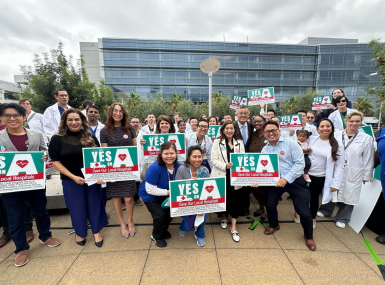COVID-19 vaccine development progressing
Upcoming Events
Related News

Key Takeaways
On November 20, Pfizer and its partner BioNTech became the first COVID-19 vaccine manufacturer to apply for an emergency use authorization (EUA) from the Food and Drug Administration (FDA). The application came days after Pfizer announced that its vaccine showed 95 percent efficacy at the completion of its Phase 3 clinical trial. While Pfizer was the first to apply for an EUA, Moderna quickly followed with an EUA application on November 30, after final analysis of its vaccine showed it is more than 94 percent effective. These recent updates in vaccine development present serious implications for counties, who will play an integral role in coordinating vaccine distribution logistics for a process that could start as early as this month.
The results from Pfizer’s Phase 3 trial provided the data needed to seek FDA approval, the final step in the vaccine development process. FDA grants Emergency Use Authorizations (EUAs) during national emergencies, when the known benefits of a product outweigh its known and potential risks. To date, the FDA has authorized 289 COVID-19 tests and 5 treatments via EUA, however, Pfizer and Moderna are the first to request approval for a vaccine.
EUAs differ from biologics license applications (BLAs), which involve a lengthier and more substantial process of FDA approval that requires significant evidence of both safety and effectiveness. Despite differences in these approval processes, FDA has firmly maintained that EUA approvals for the COVID-19 vaccine, a two- to four-week process on average, will be transparent and adhere to scientific integrity. The transparency of the EUA approval process is critical to counties’ ability to create public confidence in a vaccine. The information provided will be important to the messaging strategy employed by county public health officials who are responsible for ensuring equitable vaccine uptake.
The Pfizer vaccine will need to be stored at the extremely cool temperature of minus 94 degrees Fahrenheit. While all the vaccines in development will need to be stored at very cool temperatures, including Moderna’s, Pfizer’s vaccine appears to be the only one that requires storage temperatures below normal freezer or refrigerant levels. The storage requirements will pose unprecedented technological and logistical challenges to county governments and local points of dispensing sites, which will need to help facilitate travel and storage of vaccines. Additionally, the Pfizer and Moderna vaccines, like most others in development, will require two doses, further underscoring the need for supply, staffing and technological resources to support these efforts in local communities.
The FDA has announced that it has scheduled meetings of its Vaccines and Related Biological Products Advisory Committee on December 10 to discuss the request for EUA of a COVID-19 vaccine from Pfizer and on December 17 to discuss the Moderna vaccine. If granted EUAs, the two companies are likely to begin rapid distribution of the vaccine. Pfizer expects to produce globally up to 50 million vaccine doses by the end of 2020 and up to 1.3 billion doses in 2021, while Moderna is set to produce 20 million doses for U.S. distribution by the end of the year and up to 1 billion doses globally in 2021. Distribution of a vaccine will be resource intensive for state and local governments and is likely to strain county budgets. Although the CDC has granted states roughly $200 million for vaccine planning purposes, given the logistical and supply needs, state health officials have estimated that over $8 billion will be needed for successful distribution of a vaccine.
Counties are an essential component of any vaccine distribution strategy and, as the development of vaccines continues to progress, support for county governments and for local public health will be critical. NACo will continue to advocate for additional federal aid for counties while also monitoring, tracking and reporting on COVID-19 vaccine development and distribution updates.
For more information and resources please visit our COVID-19 Vaccine Distribution Toolkit on our NACO COVID-19 resource hub.
Related News

CMS issues new guidance on Medicaid Community Engagement Requirements
On December 8, the Centers for Medicare & Medicaid Services (CMS) released a Medicaid and CHIP Services Informational Bulletin (CIB) directing states on how to implement the Medicaid community engagement requirements enacted under Section 71119 of the One Big Beautiful Bill Act legislation (Public Law 119-21), or H.R. 1.

California county sales tax measure backfills federal healthcare cuts
Santa Clara County, Calif. will raise an estimated $330 million each year from a sales tax to backfill lose Medicaid funding.

